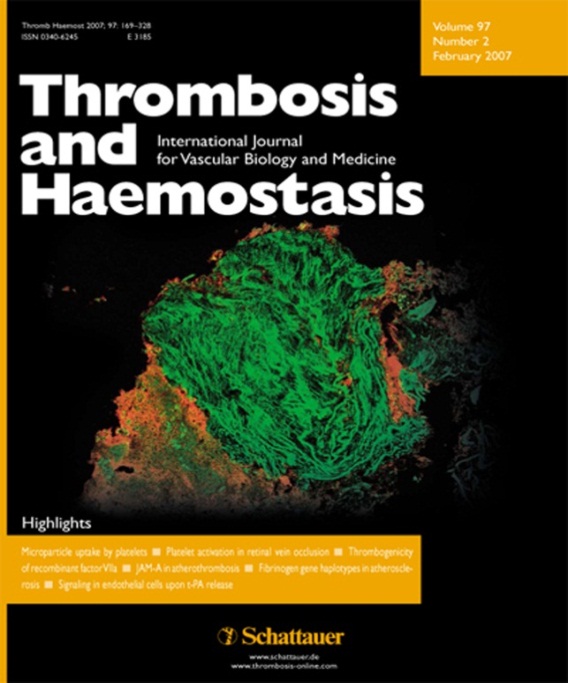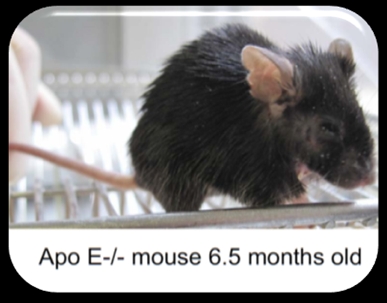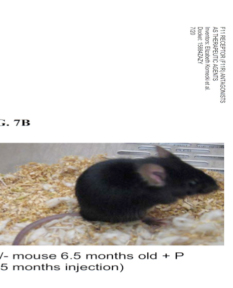
Elizabeth Kornecki, PhD
Professor Emerita
Department of Cell Biology
Department of Medicine
THE F11 RECEPTOR (F11R), A NOVEL JUNCTION ADHESION MOLECULE CRITICAL FOR PLATELET ADHESION TO INFLAMED ENDOTHELIAL CELLS: Role in atherosclerosis and athero-thrombosis.:
General research area:
Thrombosis and Hemostasis – specifically, the elucidation of cellular and molecular
mechanisms involved in the development of cardiovascular disorders, atherosclerosis
and atherothrombosis. My colleagues and I have shown that the development of these
disorders involves the adhesion of platelets to inflamed endothelial cells, and the
formation of thrombi caused by activation of circulating platelets.
Research history:
The F11 receptor protein (F11R) is an adhesion protein discovered in my laboratory
in 1986. The F11R was identified immunologically by utilization of a monoclonal antibody,
(MAb.F11) that activated the secretion and aggregation of human platelets. The F11R
protein was found to be localized on the membrane surface of human platelets (Kornecki
et al., 1990)(1). The partial amino acid sequence of F11R was published by my laboratory
(Naik et al., 1995)(2), including the cloning of the cDNA nucleotide sequence by Sobocka
et al., (2000)(3) and determination of the genomic structure, organization and promoter
analysis conducted by Sobocki et al., (2005)(4). F11R is the official gene symbol,
approved by the Human Gene Nomenclature Committee of the NIH. F11R has several synonyms
including Junctional Adhesion Molecule-A (JAM-A). The biochemical pathways operating
in the signaling pathway for platelet activation through F11R include the binding
of the Fc domain of M.Ab.F11 to the platelet Fc RII (2), translocation of specific
PKC isoforms (Wang et al., 1995)(5), dimerization of F11R, direct association with
the integrin GPIIIa, and the phosphorylation of specific amino acid residues of F11R
(Sobocka et al., 2004)(6).

Clinical implications and Drug Development:
Two synthetic peptides derived from the amino acid sequence of the F11R molecule,
named F11R peptide-1 and F11R peptide-4, were determined to be potent inhibitors of
the secretion and aggregation of platelet stimulated by M.Ab.F11. Three-dimensional
models of F11R, based on the crystal structure of the recombinant protein revealed
that the sequences of these two peptides form, within the external domain of F11R,
a pocket that forms the active site and binding domain of this protein (Babinska et
al., 2002)(7).
Studies of the effects of the F11R-inhibitory peptides and F11R soluble recombinant proteins on platelet adhesion to human endothelial cells (EC), both in-vitro and in-vivo, revealed that the adhesion of platelets to cytokine-inflamed EC can be blocked by the presence of specific F11R compounds.(Babinska et al., 2002)(8).
Under pathological conditions, high levels of F11R were determined to be present in regions of atherosclerotic plaque formation in a murine model of atherosclerosis as well as in human arteries. In the photo shown on this page (our Figure on a Journal Cover), the over-expression of F11R within the atherosclerotic plaques of human arteries is demonstrated (cover photo and keynote article by Babinska et al., (2007)(9). By silencing the F11R gene, the migration of smooth muscle cells into atherosclerotic plaques was prevented (Azari et al., 2010)(10). Furthermore, when small interfering RNAs were used for the silencing of the F11R gene in EC, the results demonstrated that transcription and translation of F11R are required for the initial step of atherogenesis induced by inflammatory cytokines (Azari et al., 2011)(11).
In two clinical studies of human cardiovascular patients, it was found that the soluble form of the circulating F11R molecule (consisting of the extracellular portion of the membrane-bound protein) was significantly elevated in hemodialysis patients (HD) (Salifu et al., 2007)(12) and in coronary artery disease (CAD) patients (Cavusoglu et al., 2007)(13). Salifu et al., concluded that F11R may serve as an important cardiovascular marker. Cavusoglu et al., demonstrated that F11R levels were independently associated with the presence and severity of angiographically defined CAD, and that F11R is an important mediator of vascular inflammation.
The clinical studies cited above also concluded that strategies which block F11R represent an important new approach to the treatment of human atherosclerosis. Initial results of our current studies, conducted by Dr. Anna Babinska and Dr. Moro Salifu of the Renal Division of the Department of Medicine, SUNY HSC, Brooklyn, support this conclusion. These studies examine the effects of inhibitory F11R - peptides on the formation and progression of atherosclerotic plaques in an animal model of atherosclerosis, the apoE knockout (KO) mouse, in-vivo. The photo on the Left below shows a representative apoE KO mouse of 6.5 months of age that is very sick - upon gross observation these animals demonstrate profound hair loss and skin sensitivities; upon microscopic tissue examination, the presence of numerous and large atherosclerotic plaques in arteries is detected.


In contrast, the photo shown on the right demonstrates a representative apoE-KO atherosclerotic mouse of 6.5 months of age, that has been treated, since the 1st month of age, with an F11R peptide (P). The F11R-peptide-treated mouse has a very healthy appearance, with no hair loss nor skin sensitivities. Upon microscopic tissue examination, significant reductions in the number and size of plaques are observed.
In a recent development we have initiated collaborative studies with Dr. Gary Olson, PROVID Inc, New Jersey, supported by a NIH grant from the Small Business Innovative Research. This collaborative research is designed for the development of drugs based on the structure and function of F11R to be used clinically. It is anticipated that this research will identify a new class of therapeutic agents that potently inhibit the pathological actions of F11R in vivo, to be used for the treatment of human cardiovascular disorders; specifically for the prevention and treatment of inflammatory thrombosis, atherosclerosis, heart attacks and stroke.
ECTO-PROTEIN KINASE ACTIVITY IS CRITICAL FOR PLATELET AND NEURONAL FUNCTIONS. We have determined that amino acid residues located at extracellular sites of F11R are naturally phosphorylated (Kedees et al., 2005)(14). The phosphorylation of external domains of surface proteins by ecto-protein kinases (ecto-PK) has a particular physiological significance in cells that secrete ATP by vesicular-exocytosis upon cell stimulation - Platelets and Neurons (reviewed by Ehrlich and Kornecki, 1987)(15). A significant extracellular protein phosphorylation activity localized on the membrane surface of human platelets and neurons was found to be a specific isotype of protein kinase C (ecto-PKC). Ecto-PKC activity in platelets was reported to play a role in the activation of latent fibrinogen receptors.(Babinska et al., 1996, Babinska et al., 2000)(16,17). Ecto-PKC activity of hippocampal neurons was found to be required for Long Term Potentiation, An initial step in the process of memory formation in the brain (Chen et al. 1996)(18).
ROLE OF PLATELET ACTIVATING FACTOR IN NEURONAL FUNCTION. Platelet Activating Factor (PAF) is an ether-phospholipid that potently induces the aggregation and secretion of platelets. Our studies in human platelets (Kornecki et al., 1984)(19) have revealed that the neuroactive compounds triazolobenzodiazepines, alprazolam and diazepam, specifically block the actions of PAF in the induction of aggregation and granular secretion. The regulatory actions of PAF in neuronal cells (Kornecki and Ehrlich, 1988)(20), were shown to involve the mobilization of calcium (Kornecki et al., 1991)(21). Furthermore, a role for PAF as a retrograde messenger in memory formation and long-term potentiation was reported by us (Kornecki et al., 1996)(22).. Platelet Activating Factor (PAF) is an ether-phospholipid that potently induces the aggregation and secretion of platelets. Our studies in human platelets (Kornecki et al., 1984)(19) have revealed that the neuroactive compounds triazolobenzodiazepines, alprazolam and diazepam, specifically block the actions of PAF in the induction of aggregation and granular secretion. The regulatory actions of PAF in neuronal cells (Kornecki and Ehrlich, 1988)(20), were shown to involve the mobilization of calcium (Kornecki et al., 1991)(21). Furthermore, a role for PAF as a retrograde messenger in memory formation and long-term potentiation was reported by us (Kornecki et al., 1996)(22).
References cited from Research Focus:
- Kornecki E, Walkowiak B, Naik UP, Ehrlich YH. Activation of human platelets by a stimulatory monoclonal antibody. J Biol Chem. 1990 Jun 15;265(17):10042-8.
- Naik UP, Ehrlich YH, Kornecki E. Mechanisms of platelet activation by a stimulatory antibody: cross-linking of a novel platelet receptor for monoclonal antibody F11 with the Fc gamma RII receptor. Biochem J. 1995 Aug 15;310 ( Pt 1):155-62.
- Sobocka MB, Sobocki T, Banerjee P, Weiss C, Rushbrook JI, Norin AJ, Hartwig J, Salifu MO, Markell MS, Babinska A, Ehrlich YH, Kornecki E. Cloning of the human platelet F11 receptor: a cell adhesion molecule member of the immunoglobulin superfamily involved in platelet aggregation. Blood. 2000 Apr 15;95(8):2600-9.
- Sobocki T, Sobocka MB, Babinska A, Ehrlich YH, Banerjee P, Kornecki E. Genomic structure, organization and promoter analysis of the human F11R/F11 receptor/junctional adhesion molecule-1/JAM-A. Gene. 2006 Jan 17;366(1):128-44. Epub 2005 Dec 5.
- Wang F, Naik UP, Ehrlich YH, Osada S, Ohno S, Kornecki E. Stimulatory antibody-induced activation and selective translocation of protein kinase C isoenzymes in human platelets. Biochem J. 1995 Oct 15;311 ( Pt 2):401-6.
- Sobocka MB, Sobocki T, Babinska A, Hartwig JH, Li M, Ehrlich YH, Kornecki E. Signaling pathways of the F11 receptor (F11R; a.k.a. JAM-1, JAM-A) in human platelets: F11R dimerization, phosphorylation and complex formation with the integrin GPIIIa. J Recept Signal Transduct Res. 2004 Feb;24(1-2):85-105.
- Babinska A, Kedees MH, Athar H, Sobocki T, Sobocka MB, Ahmed T, Ehrlich YH, Hussain MM, Kornecki E. Two regions of the human platelet F11-receptor (F11R) are critical for platelet aggregation, potentiation and adhesion. Thromb Haemost. 2002 Apr;87(4):712-21.
- Babinska A, Kedees MH, Athar H, Ahmed T, Batuman O, Ehrlich YH, Hussain MM, Kornecki E F11-receptor (F11R/JAM) mediates platelet adhesion to endothelial cells: role in inflammatory thrombosis. Thromb Haemost. 2002 Nov;88(5):843-50.
- Babinska A, Azari BM, Salifu MO, Liu R, Jiang XC, Sobocka MB, Boo D, Al Khoury G, Deitch JS, Marmur JD, Ehrlich YH, Kornecki E. The F11 receptor (F11R/JAM-A) in atherothrombosis: overexpression of F11R in atherosclerotic plaques. Thromb Haemost. 2007 Feb;97(2):272-81. Thromb Haemost. 2007 Mar;97(3):499.
- Azari BM, Marmur JD, Salifu MO, Cavusoglu E, Ehrlich YH, Kornecki E, Babinska A. Silencing of the F11R gene reveals a role for F11R/JAM-A in the migration of inflamed vascular smooth muscle cells and in atherosclerosis. Atherosclerosis. 2010 Sep;212(1):197-205. Epub 2010 May 19.
- Azari BM, Marmur JD, Salifu MO, Ehrlich YH, Kornecki E, Babinska A. Transcription and translation of human F11R gene are required for an initial step of atherogenesis induced by inflammatory cytokines. J Transl Med. 2011 Jun 26;9:98.
- Salifu MO, Kolff Q, Murty P, Haria DM, Zimpa M, Shakeel M, Lee H, Kornecki E, Babinska A. Relationship between the soluble F11 receptor and markers of inflammation in hemodialysis patients. J Investig Med. 2007 Apr;55(3):115-9.
- Cavusoglu E, Kornecki E, Sobocka MB, Babinska A, Ehrlich YH, Chopra V, Yanamadala S, Ruwende C, Salifu MO, Clark LT, Eng C, Pinsky DJ, Marmur JD. Association of plasma levels of F11 receptor/junctional adhesion molecule-A (F11R/JAM-A) with human atherosclerosis.J Am Coll Cardiol. 2007 Oct 30;50(18):1768-76.
- Kedees MH, Babinska A, Swiatkowska M, Deitch J, Hussain MM, Ehrlich YH, Kornecki E. Expression of a recombinant protein of the platelet F11 receptor (F11R) (JAM-1/JAM-A) in insect cells: F11R is naturally phosphorylated in the extracellular domain. Platelets. 2005 Mar;16(2):99-109. Platelets. 2005 May-Jun;16(3-4):249.
- Ehrlich YH, Kornecki E. Extracellular protein phosphorylation systems in the regulation of cellular responsiveness. Prog Clin Biol Res. 1987;249:193-204.
- Babinska A, Ehrlich YH, Kornecki E. Activation of human platelets by protein kinase C antibody: role for surface phosphorylation in homeostasis. Am J Physiol. 1996 Nov;271(5 Pt 2):H2134-
- Babinska A, Hogan MV, Sobocki T, Sobocka MB, Ehrlich YH, Kornecki E. Identification of ecto-PKC on surface of human platelets: role in maintenance of latent fibrinogen receptors. Am J Physiol Heart Circ Physiol. 2000 Jun;278(6):H2008-19.
- Chen W, Wieraszko A, Hogan MV, Yang HA, Kornecki E, Ehrlich YH. Surface protein phosphorylation by ecto-protein kinase is required for the maintenance of hippocampal long-term potentiation. Proc Natl Acad Sci U S A. 1996 Aug 6;93(16):8688-93.
- Kornecki E, Ehrlich YH, Lenox RH. Platelet-activating factor-induced aggregation of human platelets specifically inhibited by triazolobenzodiazepines. Science. 1984 Dec 21;226(4681):1454-6.
- Kornecki E, Ehrlich YH. Neurorogulatory and neuropathological actions of the ether-phospholipid platelet-activating factor. Science. 1988 Jun 24;240(4860):1792-4.
- Kornecki E, Ehrlich YH, Calcium ion mobilization in neuronal cells induced by PAF. Lipids. 1991 Dec;26(12):1243-6.
- Kornecki E, Wieraszko A, Chan J, Ehrlich YH. Platelet activating factor (PAF) in memory formation: role as a retrograde messenger in long-term potentiation. J Lipid Mediat Cell Signal. 1996 Sep;14(1-3):115-26.
For a list of sixty-six of Dr. Kornecki’s publications, https://pubmed.ncbi.nlm.nih.gov